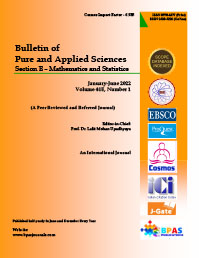A GENDER WISE SPATIAL DISTRIBUTION OF MOUTH CANCER USING POISSON-GAMMA MODEL FOR CHENNAI ZONES
DOI:
https://doi.org/10.48165/Keywords:
Disease Mapping, Poisson-Gamma model, Relative risk, Spatial Distribution, Standardized Incidence Ratio/ Standardized Morbidity RatioAbstract
Cancer is known to be one of the leading causes of mortality in the world. There were about 14.1 million incidences and 8.2 million deaths due to cancer globally. In terms of mouth cancer Age Standardized Rate is 4.0 per 100000 populations worldwide and 7.2 per 100000 populations in India. In Chennai, mouth cancer burden has significantly increased over the past decade irrespective of geographical region. In this paper, the mouth cancer incidence is used to analyze the spatial distribution for high risk and low risk areas of different zones in Chennai by gender for the period of 2004-2013. The aim of this study is to fit a Poisson Gamma model and to explore the Empirical Bayesian and frequentist approach for disease mapping of mouth cancer incidence for Chennai zones by sex. The results of the estimates reveal that the empirical Bayesian estimate is more stable than the conventional frequentist estimates.
References
. Besag, J., York, J. and Mollie, A. (1991). Bayesian image restoration with two applications in spatial statistics, Ann Inst Stat Math, 43, 1-59.
. Breslow, N. and Clayton, D.G. (1993). Approximate inference in generalized linear mixed Models, Journal of the American Statistical Association, 88, 9-25.
. Clayton, D. and Kaldor, J. (1987). Empirical Bayes estimates of age standardized relative risk for use in disease mapping, Biometrics, 43, 671- 681.
. Devine, O.J. and Louis, T.A. (1994). A Constrained empirical Bayes estimator for incidence rates in areas with small populations, Stat Med, 13, 1119-1133.
. Lawson, A.B., Biggeri, A., Boehning, D., Leasaffre, E., Viel, J.F., Clark, A., Schlattmann, P. and Divino, F. (2000). Disease mapping models: an empirical evaluation, Statistics in Medicine (Special issue: Disease Mapping with Emphasis on valuation of Methods), 19, 2217-2242.
. Lawson, A.B. (2009). Bayesian Disease Mapping: Hierarchical Modeling in Spatial Epidemiology, Int Stat Rev, 77, 325-326.
. Meza, J.L. (2003). Empirical Bayes Estimation smoothing of relative risks in disease mapping, J Stat Plan Inference, 112, 43- 62.
. Manton, K., Woodbury, M. and Stallard, E. (1981). A variance components approach to categorical data models with heterogeneous mortality rates in North Carolina Counties, Biometrics, 37, 259-269. [9]. Marshall, R.J. (1991). Mapping disease and mortality rates using empirical Bayes Estimators, J R Stat Soc Ser C Appl Stat, 40, 283-294.
. Mollie, A. and Richardson, S. (1991). Empirical Bayes estimates of cancer mortality rates using spatial models, Stat Med, 10, 95-112.
. Myint, L. and Ye, H. (1991). Study of the malaria situation in forested foothills and nearby plain areas of Myanmar, Southeast Asian Jr. Trop Med Public Health, 22, 509-514.
. Boyle, P. and Parkin, D.M. Statistical methods for registries. IARC Sci. Publ. 1991; (95): 126-58, Lyon Cedex 08, France
. Elebead, F.M., Hamid, A, Hilmi, H.S. and Galal, H. (2012). Mapping Cancer disease using Geographical Information System (GIS) in Gezira state – Sudan, J. Community Health, 2012 Aug; 37(4): 830-9, doi: 10.1007/ S 10900-011-9517-9
. George, J.M., Po- Huang, C., Tyler, S. et al (2013), Uses of GIS mapping as a public health tool from cholera to cancer, Health Serv Insights, 6, 111-16.
. Walter, S. D. (2000). Disease mapping; a historical perspective, In: Elliott, P., Wake field, J.C., Best, N.G. and Briggs, D. (editors), Spatial Epidemiology: Methods and Applications, Oxford University Press, 223-239.




